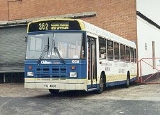
East Lancs Greenway
Encyclopedia


East Lancashire Coachbuilders
East Lancashire Coachbuilders Limited was a manufacturer of bus bodies and carriages founded in 1934 in Blackburn, Lancashire, England.In 1994 the company expanded in to new premises and commenced a programme of development that resulted in a range of single and double deck buses which was the...
from a Leyland National
Leyland National
The Leyland National is a British single-deck bus built in large quantities between 1972 and 1985. It was developed as a joint project between two UK nationalised industries - the National Bus Company and British Leyland. Buses were constructed at a specially built factory at the Lillyhall...
single-deck bus.
History
The first Greenway appeared in late 1991. It was conceived by London & Country, which at the time was part of the Drawlane Group, which owned East Lancs. L&C began a co-operative venture with East Lancs. The idea was to give some of the Leyland Nationals, of which L&C still had quite a few, a mid-life rebuild. The engineering work was carried out by L&C at Reigate, then the buses were sent to Blackburn for the replacement bodywork. Soon East Lancs made the project widespread. Many operators were in the same situation as London & Country. Since the Leyland National had an advanced integral structure which generally remained sound, it was decided that rebuilding was a cost effective option for them. The project lasted about four years, with the last of about 176 Greenways entering service early in 1996. Another major customer was London GeneralLondon General
London General is a bus company operating in Surrey ang Greater London. It is owned by the Go-Ahead Group and operates most buses under contract to London Buses...
, for the Red Arrow
Red Arrow (bus)
Red Arrow was branding given to two current and several former London bus limited stop routes used as high frequency commuter services in central London...
network in central London.
Many different types of National were included in the rebuilding programme:
- Mk 1 and Mk 2
- 10.3m and 11.3m
- Original, Series A and Series B
- Standard and Suburban Coach variants
- Single- and dual- door
However, apart from the length, these differences between the incoming vehicles made little or no difference to the finished product, since each vehicle was stripped down to the barest rolling shell, which was repanelled and given new windows, front and rear ends, and a complete new interior. The engine was replaced by a vertically-mounted, reconditioned Gardner engine (which was no longer available in new buses as it was non-compliant with new Euro-regulations).
Despite the extensive nature of the rebuilding, vehicles were eligible to retain their original identity, and some did so. However, many operators chose to apply "cherished" registrations (mostly Northern Irish), being reluctant to make it too obvious that what might appear to be a brand new bus, could in fact be anything from nine to 21 years old.
Appearance
The Greenway necessarily retained the basic shape of the Leyland National. The new side windows were of distinctive shape, with square top corners and rounded bottom corners. Plainer panelling was used than on the original National. Most examples were fitted with new doors, with two instead of four leaves. On the roof, the National's familiar "pod", which had housed heating and ventilation equipment, was discarded.Two distinct designs of front end were fitted. The first had two-piece flat windscreens which met at a slight point in the centre, EL2000
East Lancs EL2000
The East Lancs EL2000 is a type of single-deck bus body built on a wide variety of chassis by East Lancashire Coachbuilders.-Chassis:Many different chassis types, both new and secondhand, were fitted with EL2000 bodywork...
-style headlights with separate indicators above, and a normal front bumper. The second (and more common) had a two-piece "barrel" curved windscreen with level top, a revised grille between the headlights, indicators in the headlight surrounds, and a new, large bumper. Both windscreen styles had quarterlights.
Two distinct designs of rear end were also fitted. The more common was like the EL2000 rear end, having a high-set rear window. The alternative style, used on the London vehicles, had a rear window at approximately the same height as the original, and a space in the bumper for registration plates. Some had the rear route number box under the window, some had an internal box inside the window.

